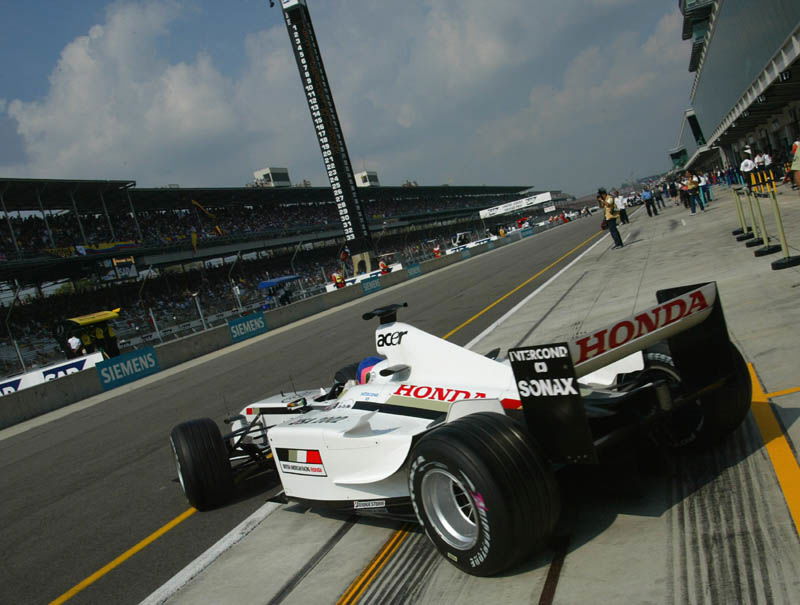Sauber gets logistical.
With each F1 team travelling about 100,000 miles in a year, which is equivalent to four times around the globe, with tons of kit and hundreds of people it's a bit of a big job keeping everything in check. Sauber's been looking into everything involved...
Per racing season, each of the ten Formula One teams travels about 150'000 kilometres, in the air or on the ground, which means the teams go around the globe nearly four times. In addition to hundreds of people, the teams also move tons of material and equipment.
With each F1 team travelling about 100,000 miles in a year, which is equivalent to four times around the globe, with tons of kit and hundreds of people it's a bit of a big job keeping everything in check. Sauber's been looking into everything involved...
Per racing season, each of the ten Formula One teams travels about 150'000 kilometres, in the air or on the ground, which means the teams go around the globe nearly four times. In addition to hundreds of people, the teams also move tons of material and equipment.
Particularly for overseas races this turns into a major logistical challenge. Innovative approaches are helping Sauber Petronas to effectively manage such tasks.
It goes without saying that personnel and equipment transports, which from March through October are normally organised once every fortnight, require careful preparation, down to the smallest detail. For overseas races, the scope of this effort is truly a logistical masterpiece.
Each team, for example, is responsible for making its own arrangements for accommodations, hire cars and catering. For races staged at Australian, Asian, North and South American venues the teams have to shoulder the additional burden of packing their equipment for transportation aboard aircraft, arranging transfers to the departure points and ensuring that the requisite facilities, systems and services are available at the respective circuit.
For the upcoming Grand Prix in Indianapolis on September 28th, Team Sauber will be moving 51 people and 24 tons of equipment to the United States. Urs Kuratle, who is also the team's Chief Mechanic, organises this effort. Under the direction of the 35-year-old Swiss, who joined the Hinwil squad in 1989, Sauber has streamlined its own logistics processes for optimum efficiency. Instead of packing vehicle components, tools, pit equipment and spare parts into dozens of differently sized flight cases, the team is now putting all of its equipment into four huge containers. Shape and dimensions of these containers have been adapted to the egg-shaped cargo compartment of the transport planes.
Kuratle's innovation not only saves considerable time for packing the team's equipment but also helps to lower freight charges, which are based on weight and volume. Although the FOM (Formula One Management) absorbs these costs up to a certain level, the teams' "freight allowance" by no means covers the total expense incurred.
The team's standard equipment for overseas races includes three complete cars, one spare chassis, six to eight spare engines, an equal number of floors, eight rear wings, six front wings, 60 wheels, two complete rear axles with gearboxes, one separate gearbox plus additional spare parts, such as wishbones and uprights as well as cleaning, press and promotional material. Among those items which literally carry particular weight are the four "Lista Boys" cupboards for tools totalling nearly three tons, the 1.5-ton pit equipment with lighting, computers weighing 1.5 tons, as well, and the two refuelling rigs which tip the scales at half a ton.
Forklift trucks, roll carts, cabinets, copying machines, water, compressed air, generators, furniture and telephone lines are supplied under local contracting arrangements at the respective circuit. Tyres and so-called dangerous cargo, like petrol, engine and gearbox oil, glue and brake fluid, are also supplied by the team's technical partners.
Some of the logistics tasks are handled by the FOM. Alan Woollard and his son Adam are the teams' points of contact for transports. The two FOM officials charter six Boeing 747 or MD 11 aircraft. Four of them are loaded in London, two in Munich (for the teams based outside the UK, i.e. Toyota, Minardi and Sauber). Ferrari have been organising their logistics operations independently for some time. Two weeks prior to the departure date, the volume and weight of the team's air freight must be reported to the FOM. The FOM then informs the teams of the exact date and time, down to the minute, at which the equipment must be at the airport for loading.
In Hinwil, the containers to be sent to Indianapolis for the U.S. Grand Prix were packed as soon as the team returned from Monza. Thanks to Sauber's new system, cargo space requirements are no longer subject to variation. After weighing the team's equipment and preparing the requisite bill of lading and customs declarations, a forwarder hauls three truckloads of material to Munich for loading aboard one of the two aircraft, either on Friday or Saturday before the race weekend (depending on the FOM schedule).
On Sunday, Urs Kuratle and seven truck drivers will be flying to Chicago. The next day, they'll be heading for Indianapolis to unload the containers awaiting them at the circuit. In the early hours of Tuesday evening, the pit garages will be operational. 24 hours later the offices will have been completely furnished and any additional shipments from Hinwil received. The other team members, travelling in groups, will start coming in, with Peter Sauber and some key personnel, usually arriving last.
Immediately after the chequered flag has been waved in Indianapolis, the team will be getting ready for the race in Suzuka. Parts which require maintenance like rear axles and suspension components, are taken back to Switzerland. By Monday morning, the engines need to be changed, rear axles from the spare stock installed and minor maintenance work performed. Everything will again be packed into the containers for dispatch to the season's finale in Japan immediately afterwards.
This year, most of the Swiss team's personnel will be returning to Europe between the two Grands Prix - as opposed to last year, when they were able to spend a week's holiday in Hawaii, along with members of other teams.
The calendar of the current season comprises 16 races - ten of them in European countries and one each in Melbourne, Kuala Lumpur, Sao Paulo, Montreal, Indianapolis and Suzuka. In future, there will be even more Grands Prix staged outside of Europe, as Formula One continues to shift its focus eastward. As early as in 2004, Bahrain and Shanghai will be Grand Prix venues, Turkey will follow in 2005, and India as well as Russia are prepared to fill any potential needs.
The trend towards staging more Grands Prix at overseas venues will expand the current scope of logistics. Even now, these tasks require considerable organisational skills, resourcefulness, diplomacy, discipline and strong nerves. No doubt, Urs Kuratle and his team will master the challenges of the future, as well...

